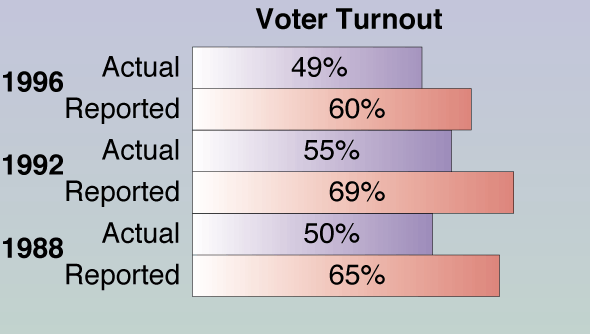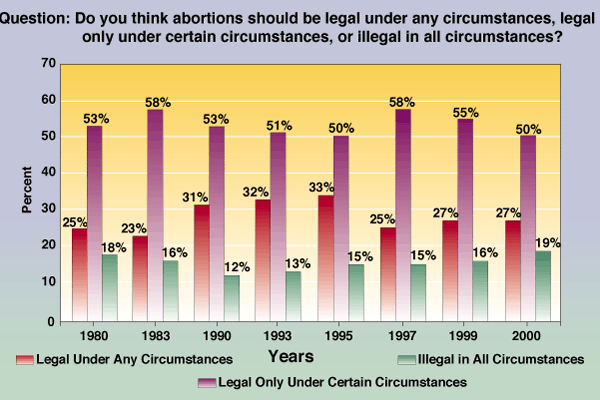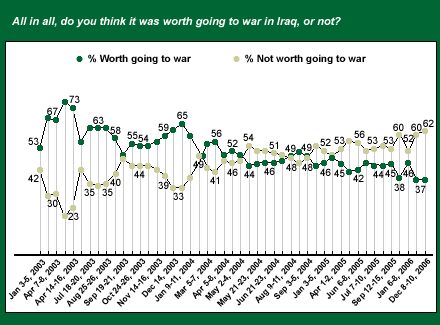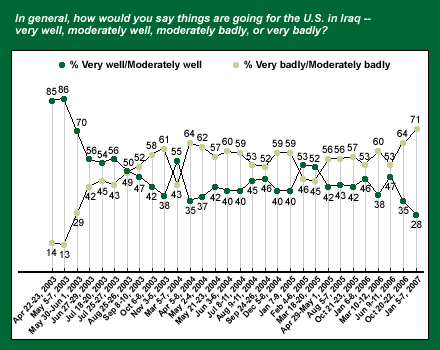Part of the problem of responding to the will of the people is knowing it when you see it. (Please read the "Can we believe the polls" section for some general methodological comments about polling, p. 139).
Public opinion often lacks consistency due to the "non-attitudes" issue. "Socially desirable" responses correspond to whatever the respondent thinks the interviewer is likely to want to hear (e.g., thus, politically correct responses get overrated). Dye refers to this as a "halo effect" and is demonstrated in the graph below which shows that respondents anticipate that voting is perceived as a good thing and thus overreport their propensity to engage in this "good thing."
As what is considered socially desirable changes, public opinion may change as well, but without any real depth to the opinions being polled.
Subtle changes in question wording might also make a difference. Obviously, those with integrity in the polling industry know to avoid biased or loaded questions. But what about merely different ways of asking the same thing?
For example, if we wanted to know the public’s views on abortion, we could ask a series of different questions which might affect our conclusions regarding just how much "pro-choice" or "pro-life" sentiment exists in the public. Dye’s pages 142-43 present an interesting overview of polling on this question. Page 143 especially presents a range of opinions, depending on the specific question and how it is worded. The abortion issue is pretty "mature" and thus wording effects are not as great as might be expected.
Other topics might not be as mature, and thus subject to wider variations depending on events of the previous day or week.
The War in Iraq
The percentage thinking that "the war in Iraq has been worth the trouble" varied considerably during 2003-2006, probably due to media reported events of the day or week (see Gallup poll results in the graph below). Clearly there are sharp peaks when Iraq holds an election or when Saddam is found, and dips when more troops get killed and civil war seems without end.
Another Gallup question:
Which comes closest to your view about the war with Iraq – [ROTATED: you are certain that the U.S. will win, you think it is likely that the U.S. will win, but you are not certain, you think it is unlikely that the U.S. will win, but you are not certain, (or) you are certain that the U.S. will NOT win]?
Certain will win% Likely but not certain% Unlikely but not certain% Certain will not win% No opinion %
2007 Jan 12-14 17 30 27 22 4 2007 Jan 5-7 16 34 28 18 4 2006 Mar 10-12 22 32 25 16 6 2003 Apr 5 ^ 79 17 1 -- 3 2003 Mar 29-30 69 25 3 1 2 As you can see, there was a sharp drop in confidence about the outcome of the war in Iraq from the time when the war first started in March 2004 to January 2007, when less than a majority felt that it was at least likely that the US would win the war. This again points to the volatility of public opinion, shaped as it is by events, news reporting and actual experiences.
Clinton's Affair
It might be interesting to have polled the public prior to Clinton's affair with Monica Lewinsky to see how tolerant the public would have been of "a president found to have had an adulterous affair while in office." Could we have anticipated Clinton’s strong job approval, even after being impeached (his cumulative job approval rating was 57%, higher than Ronald Reagan's)?
How have public perceptions of the "fairness" with which George W. Bush "won" election in 2000 affected his ability to govern - even after the 2004 election? Could there be an underlying sense that had Bush not "won" the 2000 election, the war in Iraq might have been avoided - an outcome which the polling presented above indicates the public would have favored (in hindsight, naturally).
These are either unknown or incongruous polling findings that make it hard to know what the "people" want...
Party, Ideology and Issue Polarization
The literature on party affiliation or identity assumes that once people have made a choice about a party, they align in predictable ways with the views dominant in each party. However, this assumes that ideology and party are virtually synonymous. We have already discussed the meaning of "Liberal" and "Conservative" while discussing chapter 2, so you already have an image of the differences among those who are strongly ideological. What is less clear is whether party proves to be a clear predictor of the moral acceptability of certain practices. Since we can assume that ideological differences will differentiate the 'extremes' within the parties, it seems likely that something less than complete polarization will characterize differences between partisans.
The chart below is based on a Gallup poll taken May 2-5, 2005. It shows the responses to the question "Is practice X morally acceptable to you" as differentiated by party. On the left side are those practices most generally acceptable to all, while to the right are those things least acceptable to all. Thus, 70 percent of the public favors the death penalty, even though there is a 15 point gap (79%, 61%) between Republicans and Democrats. Conversely, only 12 percent of the public finds suicide morally acceptable, even though there are more Democrats (15%) who find it acceptable than Republicans (9%).
However, when the chart is resorted to emphasize the issues with the greatest differences between the parties, the ideological "hearts" of the parties are better revealed.
In the chart above you can see that there for only three issues do Republicans favor a practice more often that Democrats: animal fur, death penalty and medical testing on animals. For the other 13 issues, Democrats are more tolerant than Republicans, with the greatest differences on divorce, having a baby outside of marriage, abortion and stem cell research. Overall, then, it is possible to see that Democrats are more 'open' to a variety of practices that are on the cultural 'cutting edge' - more liberal in that sense. Republicans are more traditional or conservative, although remember that these charts show that differences on a variety of issues such as divorce, sex between an unmarried man and woman and even stem cell research, around 50 percent or more of Republicans also find such practices to be morally acceptable.
The main point, therefore, is that while it is likely that Republicans are more conservative than Democrats, it is important not to overly exaggerate these differences.
Party and Presidential Job Approval
The importance of party identification can also be illustrated by the following graphs, which highlight George W. Bush's Presidential job approval through July 2005. The first graph simply shows the contrast between Bush's highest approval coming in the immediate aftermath of the terrorist attacks of September 11, 2001 and the July 2005 findings.
Graph 1: High/Low Job Approval for George W. Bush
The second graph shows the small "honeymoon" period which Bush received immediately upon reelection, when his "approval" was below above 50%. He expected a 9/11 based "rally effect" which lasted around 18 months, temporarily boosted further by the start of the war in Iraq (March 2003). As you can see by February of 2004, the disapproval edged up to around 50%...by the June 2005 poll, 53% disapproved of the job he was doing. As of Feb 8, Gallup reports his job approval score as 37%.
Graph 2: George W. Bush Job Approval 2004-2005
Finally, as we can see in the graphic below (Graph 3), extreme polarization around party identification symbolized the severe partisan divide afflicting the country. Around 90% of Republicans approved of Bush's job, while a similar percentage of Democrats disapproved. The "swing voters" who are independent tended to side with the Democrats, with 58% disapproving of Bush's job as President. As you can see, with such polarization, the great bulk of the public interprets the President's actions through the lens of partisanship.
Graph 3 - Party Identification and Presidential Approval
Historical Look at Presidential Disapproval Ratings
Tuesday, June 28, 2005
by Joseph Carroll (Gallup Organization)
Much of the attention paid to public opinion polls on a president's performance in office focuses on the percentage of Americans who approve of the way that person is handling his job. But what insights can be gained by looking at presidential disapproval ratings?
George W. Bush
The latest CNN/USA Today/Gallup poll, conducted June 24-26, finds that 45% of Americans approve of the way George W. Bush is handling his job as president, while a slim majority, 53%, disapprove. Since he took office, Bush's lowest disapproval ratings occurred in September 2001, a little over a week after the terrorist attacks in New York City and Washington, D.C. A Sept. 21-22 poll found 90% of Americans approving and only 6% disapproving of Bush. In contrast, the current results represent the worst ratings of Bush's presidency. The current approval rating ties Bush's lowest (45% in March 2005), but this poll finds his highest disapproval rating ever.
An analysis of Bush's disapproval ratings on a year-to-year basis shows that just about a quarter of Americans, 24%, disapproved of Bush across 31 polls conducted in 2001. This disapproval average declined by two points in 2002, to 22%. Beginning in 2003, Bush's disapproval average started to increase sharply. About a third of Americans (35%), on average, disapproved of Bush in 2003. This jumped once again in 2004, when 46% of Americans, on average, disapproved. Across the 20 surveys conducted since the start of this year, 47% say they disapprove of Bush -- not much different from what Gallup found last year.
Republicans and Democrats vary significantly in their views of Bush: although the vast majority of Republicans approve of Bush's job performance, there are just as many Democrats who disapprove. The June 24-26 poll finds that 89% of Republicans approve of Bush, while just 10% disapprove. This compares with 11% of Democrats who approve of Bush and 88% who disapprove of him. Among independents, 37% approve and 58% disapprove.
Historical Comparisons
Ever since Gallup first started asking Americans to rate the president in the late 1930s, seven other presidents have experienced a time when a majority of Americans have disapproved of them. Only four presidents never had a disapproval rating over 50%: John F. Kennedy's highest disapproval was 30% about two weeks before his death; Dwight Eisenhower's highest was 36% in March 1958; and both Franklin D. Roosevelt and Gerald Ford scored a 46% disapproval rating as their highest.
- Bill Clinton's highest disapproval rating was 54% in September 1994. In fact, several polls that year found at least 50% of Americans disapproving of Clinton's performance as president.
- In the summer of his re-election bid, 60% of Americans told Gallup they disapproved of the way George H.W. Bush was handling the presidency. Across the 14 polls conducted from May 1992 through October 1992, a majority of Americans expressed disapproval in Bush.
- In January 1983, 56% of Americans said they disapproved of Ronald Reagan. Five polls conducted from December 1982 through February 1983 found at least 50% of Americans disapproving of Reagan.
- Many of the polls conducted in 1979 and 1980 found majority disapproval of Jimmy Carter's performance. His highest disapproval was 59% in June and July 1979.
- Just prior to his resignation as president, 66% of Americans said they disapproved of the way Richard Nixon was handling the presidency.
- In March 1968, Gallup found that 52% of Americans disapproved of Lyndon B. Johnson. Johnson's disapproval ratings were at 50% or higher only four times in his presidency.
- Harry Truman scored the highest disapproval rating in Gallup's history -- 67% -- in January 1952. Truman also scored the lowest approval rating in Gallup's history, 23%, in the same poll.









